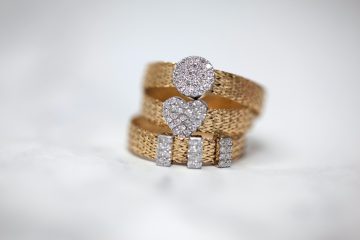White gold or white gold as it is also called is an alloy of several different metals. Thus, it is not an element in the same way that “ordinary” gold is. White gold is a very popular choice in jewelry, especially wedding rings. In this article, we look closer at this material which has only become more popular over the years.
What is white gold?
White gold is an alloy (mixture) of various metals. The mixture may differ slightly, but a common variant is gold, silver, palladium and copper. It is the palladium that gives white gold its bright color and luster.
White gold jewelry is often plated with a thin layer of rhodium. Rhodium gives the white gold an even lighter tone and stronger luster. On jewelry, for which white gold is used extensively, the rhodium is eventually worn off. For example, if you have a wedding ring in white gold it may need to be treated with a new round of rhodium after a few years.
White gold is a relatively new invention
Goldsmiths began experimenting with various alloys to obtain a lighter variant of gold during the late 19th century. But white gold began to be used on a large scale in the jewelry industry only during the 1920s when an alternative to platinum was wanted by the market.
During the first years of the 1900s, platinum jewelry had become trendy. But very few could afford a piece of jewelry in the exclusive metal because platinum at that time was extremely rare and expensive. Platinum was mined only in a few places in the world and on a small scale. The price of platinum was therefore considerably higher than the gold price.
To meet demand, more and more jewelry manufacturers began to offer white gold alternatives. White gold jewelry quickly became a bestseller and many discovered that the light metal did very well with diamonds.
White gold history
White gold is an alloy of various metals, usually gold, copper, silver, and platinum or palladium. In the past, it was common to use the much cheaper metal nickel instead of the platinum or palladium used today to give the white gold its characteristic white color.
Nickel was common in white gold until the 1970s when it became increasingly known that nickel causes allergic reactions such as skin rash in many people. We were quick to pay attention to the problem and in many countries, it is forbidden to sell jewelry that contains too much nickel. Since the nickel was phased out, it is usually palladium that gives white gold its bright color. Modern white gold has a grayer tone than the older mixtures containing nickel. For this reason, white gold is often plated with rhodium.
Most white gold jewelry consists of 18-carat gold but also 14 carats.
Various blends of white gold
As you know, plain gold is yellow. To obtain the white color that white gold has, the gold must be mixed with lighter metals. However, mixing gold with the documented light precious metal silver does not produce white gold as many believe. For example, if you mix 75% gold with 25% silver you get 18-carat gold. But it won’t be white without green gold. Due to the nickel ban, palladium is mainly used today.
A common mix used by jewelry manufacturers is 75 percent gold plus 16 percent palladium. The rest consists of copper and silver. Silver is and copper is a soft metal and makes alloy easier to process in jewelry making. Copper is also a tough and strong metal that makes the mixture more durable and does not crack when processed.
How much platinum is needed for the gold to turn white depends on the purity of the gold you are starting from and what carat content the finished piece of jewelry should have.
Some common blends of white gold:
- 18 carat white gold: 75% gold 15-16% palladium and 9-10% silver
- 14 carat white gold: 58.5% 31.5% and 15% palladium
- 9 carat white gold: 37.5% gold 59% silver and 3.5% copper (gets a grayer tone than mixtures containing palladium or platinum)
In many countries, it is still common to mix in nickel in white gold. In countries where it is still allowed to sell jewelry containing nickel, 18-carat white gold may consist of 75% gold, 10% palladium, and 5% zinc or nickel. Some mixtures of 14-carat white gold may contain more than 12% nickel, which is definitely sufficient to cause allergic reactions. Therefore, one should be careful about buying jewelry white gold from countries where this is common if you are allergic to nickel.



